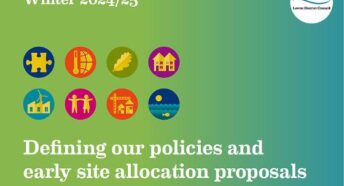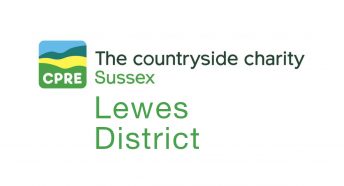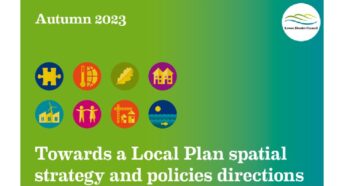Lewes District Update January 2023
A Planning Crisis in Lewes District.
Since May 2021 developers have been bombarding Lewes District with application after application for new car-dependent housing developments on countryside sites around the District’s Low Weald villages outside the South Downs National Park – Ringmer, Barcombe, Cooksbridge, Chailey, Newick, Plumpton and Wivelsfield are all being targeted, while the “Eton Mess” plans a whole new town on the countryside around little East Chiltington.
To date the councillors on the Lewes District Planning Committee have taken a strong line in refusing all the planning applications that are outside the adopted Local Plan. Lewes District CPRE and our town and parish councils have worked hard to encourage them, and they have responded. However, several developers have taken their cases to appeal, and four appeals in a row, in Wivelsfield Green, Plumpton Green, Ringmer and Newick have all been allowed by the Planning Inspectorate. None of our arguments have so far been accepted by the appeal inspectors. Further appeals at Ringmer and Wivelsfield Green are awaiting decision.
This of course will discourage our councillors, and encourage yet more speculative developers to try their luck. When they win an appeal developers reap huge windfall profits. Land worth perhaps £10K per acre as farmland soars to over £1M per acre with outline planning permission. What the country needs is the right type of new housing at sustainable locations, but what is most profitable to developers, what they are keenest to deliver, and what the appeal inspectors have allowed, is car-dependent commuter housing built on the countryside. All our District councillors are of course up for election again in May, so we can hope that they will remain responsive to public opinion until then.
What has caused this crisis?
After several years’ careful work and detailed examination by a Planning Inspector the Lewes District Local Plan for the period to 2030 was finally adopted in 2016. Central government had assessed the housing need for Lewes District as about 500 new homes per year, but the Inspector, after listening carefully to arguments from developers, the council and bodies such as CPRE Sussex, decided that 345 p.a. was the maximum number that could reasonably be delivered. Part of the argument was that in Lewes District there are more deaths each year than there are births, so the government’s “housing need” is to accommodate an arbitrary number of people moving in to Lewes District from elsewhere, mainly from Greater London.
The new Local Plan housing sites identified were a mixture of brownfield redevelopments in Lewes and Newhaven and greenfield sites in the countryside. Lewes District is now actually meeting its 345 p.a. demanding target, though so far it is mainly the greenfield sites, most profitable to the development industry, that have actually been delivered.
Then, in 2018, Mrs May’s government changed the rules. First they decided that Local Plans should be “reviewed” every five years, which sounds superficially reasonable. The 2016 Lewes Plan needed to be reviewed by 2021. Secondly they imposed a new algorithm to calculate “housing need”. The base number for Lewes District in the new algorithm remained about 500 p.a., but now it was to be multiplied up by an “affordability factor” (determined by the relationship between house prices and wages in the District), that took this up to just short of 800 new homes every year. This is a frankly ridiculous target that will never be delivered. CPRE doesn’t believe it is intended to be delivered – it is the exact opposite of every housebuilder’s business model to build so many houses that the price collapses, which is what the “standard method” algorithm claims to set out to achieve. What it does do, however, is enable developers to claim that the District’s housing delivery is so far below the inflated “housing need” that every appeal must be allowed.
So why doesn’t Lewes District just review its Local Plan? To do so it would need to plan for 800 new houses per year, for at least 15 years – so for 12,000 new houses. That would be a new town the size of Seaford. Few can be in the National Park, while the coast is almost entirely built up already. There is no infrastructure for all these new houses in the Low Weald villages, and no plan to provide any. Lewes D.C. (like every other rural District Council in Sussex) is being set an impossible task it is bound to fail. But developer party political contributions to the government are buoyant!
So what can CPRE members do?
The Department of Levelling Up, Housing and Communities (headed by Secretary of State Michael Gove) has been made forcibly aware of the discontent this policy is causing in the countryside areas most affected, like ours. The government has experienced some dramatic by-election losses, while our neighbouring Wealden District has seen Green party councillors elected in such normally deep-Blue wards as Hartfield and Maresfield.
Mr Gove has taken two recent steps.
First on 6 December 2022 he issued a ministerial statement. Some parts appear encouraging, but overall it shows considerable ambiguity. It remains to be seen what weight appeal inspectors will give it in their decisions.
See: https://questions-statements.parliament.uk/written-statements/detail/2022-12-06/hcws415
Secondly he has announced proposals to amend the National Planning Policy Framework (NPPF), the key planning regulations.
The more CPRE members respond, the better. The deadline for responding to this consultation is 2 March 2023. Responses to many of the proposals are straightforward. Yes, every CPRE member will want more weight given to Local Plans and Neighbourhood Plans, and for there to be fewer ways for speculative developers to undermine them; everybody sensible wants new development to be beautiful and accompanied by the necessary infrastructure; of course the new housing required should be delivered over the whole plan period, and councils should not be penalised if too much comes forward too early; of course flexibility is a good thing; of course councils should not be penalised when they have granted planning permissions but the developers have not built the houses; of course we must protect the environment and combat climate change (e.g. by building far fewer houses at car-dependent locations); of course we should focus on building the types of houses we actually need; of course food production should be protected, and flood risk minimised. While some national development management policies might be welcome (such as minimum space standards), one size does NOT fit all for design matters – different parts of England are different, and those differences are valued and a matter for local people.
However: the key question to respond to is Question 7. This question proposes to retain the absurd ‘Standard Method’ algorithm for determining housing targets, including its indefensible affordability factor. That is what creates the absurdly high targets in Lewes and other Districts. Please respond by stating as strongly as you feel able:
- That the “housing need” assessment is, for our District at least, neither objective nor fair.
- That the “affordability factor” is indefensible and unjustifiable.
- That it is the absurdly high targets this algorithm creates that is responsible for so many councils not being able to deliver Local Plans.
Reviewing the Lewes District Local Plan
Lewes District Council are still in the process of reviewing their 2016 Local Plan, a process that under the current rules is likely to take at least another 2-3 years. Their first round of consultation produced a huge number of responses, and officially these are still being analysed. The next step is for the Council to publish its preferred options, about where to deliver the ludicrously high number of 12,000 new houses required by the “standard method”.
This is unlikely to make the Council popular, whatever they propose, and there are elections in May. The uncertainty about the future national rules (certain to change but who, at the present time, knows how) has led councils up and down England to decide to put their plans on hold until the situation is clearer. It is thus entirely unsurprising that Lewes had deferred this controversial next stage until the autumn.
Planning in the South Downs National Park
About a third of Lewes District lies within the South Downs National Park. This includes the whole of the town of Lewes. The SDNP Authority is the planning authority for this part of the District, and they have only just started the process of reviewing their 2018 Local Plan. They have, however, produced a number of Supplementary Planning Documents such as that on design which has been a helpful addition. National Parks, with their protected landscapes, are treated much more leniently by the NPPF, and the “standard method” does not for them lead to a “tilted planning balance”. Most of the more aggressive developers steer well clear of them. The review is not expected to be too controversial, though we shall maintain a careful watching brief.
Monitoring Planning Applications
Throughout the county CPRE Sussex has a network of volunteers who monitor the weekly lists of planning applications to identify those that would be damaging to the countryside and are contrary to our Local and Neighbourhood Plans, and to national planning policy. In Lewes District this is undertaken by John Kay, Robert Cheesman and Paul Stevens. Where appropriate we visit the sites to form our own impressions. We aim to work closely with our town and parish councillors, build relationships with our MPs and District councillors, and with their key officers. We recognise the very significant pressures that these elected representatives and officers work under. We ensure that controversial applications are brought to the attention of the local media, who often give them wide local coverage. Where appropriate we attend meetings of the Lewes and SDNP Planning Committees and express our views. In cases where the decision is one of refusal the applicants often appeal, and at this stage our arguments need to be factually based and presented in a professional way. Again speaking in person before an Inspector at an Inquiry is often necessary to advance our case.
Southern Water “Storm Overflows”
Alongside the planning work we have also been much concerned about infrastructure issues, including the discharge of untreated sewage into streams and watercourses and onto beaches. This is unavoidable when there is exceptionally heavy rain, and that rainwater is allowed to find its way into the foul sewage system, as was often allowed in the 20th century. In new development rain water and foul sewage are carefully separated, but the historic problem remains. Retrofitting separate rainwater and foul sewage systems to older housing stock is at best extremely expensive, and often physically impossible, especially in the many Sussex towns and villages built on impermeable clay.
No-one wants foul sewage to back up into houses and gardens. However, Southern Water have allowed this problem to get worse and worse, so in villages like Ringmer sewage has to be discharged untreated virtually every time it rains. The company routinely reassures planners that the sewage works will be able to cope with extra new houses (without mentioning that this only applies while the weather is dry! Southern Water now claims it will be addressing this problem, but that is not supported by any of the necessary provision in any of its forward investment plans! We have ensured substantial media publicity about this problem, and will continue to hold the Company to account
Biodiversity Credits
The new requirement that all development should result in at least a 10% increase in biodiversity is, in principle, very welcome. Who could possibly object? However, the criteria for meeting this requirement appear somewhat elastic.
At a recent Ringmer appeal it was admitted by the developer that his development would seriously reduce the biodiversity of the appeal site, which included a long-established pond supporting a colony of great crested newts (to be destroyed) and was a “special site” for reptiles, with grass snakes, common lizards and slow worms living there. All this was to be lost. However, the required biodiversity improvement was to be achievement by the payment of a very modest sum to purchase “biodiversity credits” from a “biodiversity credit broker” that would allegedly result in the improvement of a countryside site more than ten miles away, near Haywards Heath. Does this trigger anyone else’s “scam alert” sensors?
CPRE Sussex Visits
Until halted by Covid CPRE Sussex had been developing an excellent programme of very popular visits for its members each year, including several to country locations not normally open to the public. You had to book early to get a place. After two years in abeyance, this programme resumed last year.
We hope it will be back in full in 2023, but the CPRE Sussex Office does need to recruit some new members to the team who organise these. It would be good to have someone from Lewes District, where there are a good number of opportunities, volunteer to join this team.
Could you help? If so please contact lesley.wilson@cpresussex.org.uk.
Your Lewes District Committee
We are very grateful for your support of CPRE whether it be by participating in campaigns, volunteering or simply financial. Unfortunately your Lewes committee has gradually reduced in size in recent years as its members have aged. We need to recruit some new members and it would be good if we had representatives from all the larger villages in the District. We hold an annual AGM and hold perhaps 4-5 afternoon meetings each year. It is thus not a great burden to take on and you will certainly learn a lot more about your District and its issues. If you feel able to join us please contact either our Chairman or Secretary, their contact details being at the foot of this newsletter.
2023 Lewes District AGM
Our intention is to hold our 2023 AGM with an interesting speaker in one of our villages in the summer months. Barcombe, with its excellent Village Hall, is our preferred option for 2023.
Before making any arrangements it would be helpful to know whether you would prefer a Saturday afternoon or weekday afternoon or evening meeting. Would you please let us know your preference by emailing Robert Cheesman (by the end of February) or please leave a message on our office ansaphone, contact details below:
Contact details
Chairman –John Kay, Fair Meadow, Rushey Green, Ringmer BN8 5JB johnkay56@googlemail,com
Secretary – Robert Cheesman, 26 Old Malling Way, Lewes BN7 2EG robertcheesman@btinternet.com
CPRE Sussex office: 01825 890975
Download a copy of the above newsletter: CPRE Lewes District newsletter January 2023





